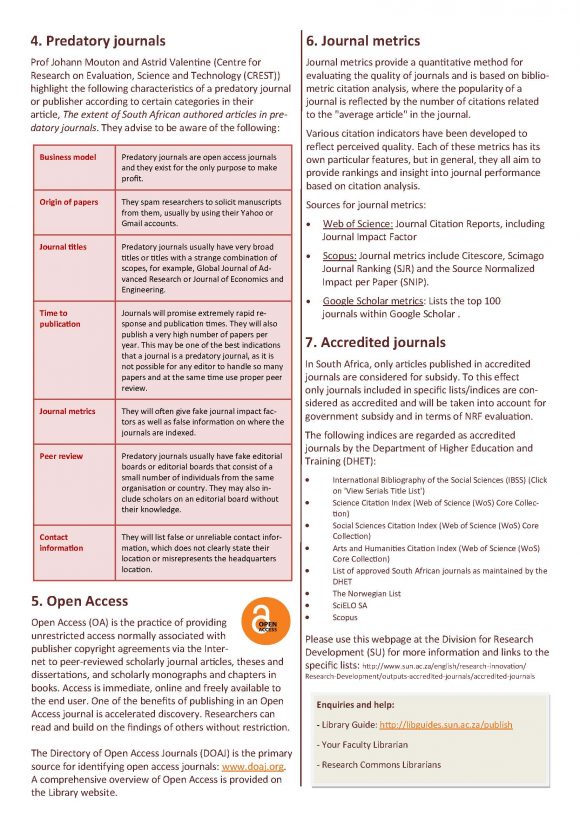A handout about seven important aspects to consider when publishing, is available from the Library. The content will give you guidance about the qualities of a good journal, how to match journal and article types, predatory journals, Open Access, journal metrics and accredited journals. See the handout below. You are also welcome to download the pdf version here: Publishing_handout. More detailed information on the topic is also available in the full Library Guide: Where to publish your research article. For one-on-one consultation and advice, please contact your faculty librarian or Research Impact staff.
Month: August 2018
This post was originally published as an article in Bibnuus, the Library’s electronic newsletter.
What is research data management?
It is like a shadow in the darkness, a mystery lingering in academic minds, the words themselves have been whispered in the corridors all across campus: What is research data management?
To adapt what legendary investor Philip Fisher wrote in relation to the hullabaloo about dividends in his famous investment classic Common Stocks and Uncommon Profits:
There is a considerable degree of twisted thinking and general acceptance of half truths about a number of aspects of research data management. However, whenever the significance and importance of research data management is considered, the confusion of the typical researcher becomes little short of monumental.
In summary, research data management can be described as a process which consists of two components:
- firstly, planning for the manner in which research data will be managed during and after the research process; and
- secondly, controlling the collection, processing, analysis, sharing, dissemination, curation and reuse of research data.
So what is the hullabaloo about research data management?
In the past decade the management of research data has come take on a more prominent role in tertiary education institutions around the world. This has been primarily due to the increasingly data-centric nature that academic research has taken. At the same time academic institutions have come to be influenced by the Open Access movement which advocates for the unrestricted access and use of published research outputs. A convergence of these two developments has culminated in a call for the unrestricted access and use of research data. The move itself is being pushed through by research funding agencies. In recent years, some of Stellenbosch University’s research funders have instituted mandates that require the implementation of adequate research data management practices in order to enable the open access of research data. Such practices should comply with certain best practices such as the following:
- research data should be managed through the creation and submission of data management plans; and
- research data should be findable, accessible, interoperable and re-useable.
What are the implications?
The recent developments relating to Open Access and Open Science have necessitated the creation of a research data management system at the university in order to facilitate adequate research data management practices. As a leading research institution, Stellenbosch University would like to address this issue by taking the necessary steps in order to adopt appropriate data management practices. Thus over the foreseeable future, students and staff members at the university can expect to see a number of developments related to the creation of our university’s research data management system.
Watch this space for future developments!
Samuel Simango
Manager: Research Data Services
ssimango@sun.ac.za
Rudolf Marloth (1855-1931), a German chemist and pharmacist who immigrated to the Cape of Good Hope in 1883, is regarded as one of South Africa’s greatest early botanists. Marloth is best known for his magnum opus, The Flora of South Africa, compiled between 1912 and 1932 in collaboration with botanical illustrator, Ethel Dixie. Over the years the Marloth family donated the original illustrations and plates with handwritten notes to Stellenbosch University Library. This precious collection has now been taken up in the SUNDigital Collections of the Stellenbosch University Library.
Marloth’s association with Stellenbosch University started in 1888, when he was appointed as a lecturer in Chemistry and Experimental Physics at the then Victoria College, the forerunner of today’s Stellenbosch University. He was promoted to professor in 1889, but gave up this position in 1891. Later he became involved again as a lecturer in science at the then Government School for Agriculture and Viticulture, today’s Elsenburg. In 1922 the University of Stellenbosch awarded him with an Honorary Doctorate in recognition of his contribution to the understanding and knowledge of the Cape Floral Kingdom.
The Special Collections Division in the Stellenbosch University Library also hosts many of his personal documents, correspondence and photographs.
Marié Theron


